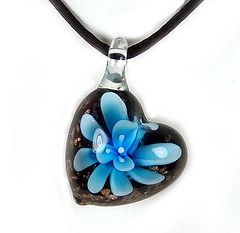
Thousand flowers all trapped in glass
Millefiori, say Italians. Thousand flowers, say English-speaking people. Words bring to mind cherry blossom festival in Japan, or fields of wild flowers on the hills of Tuscany. It is the name for one of the most beautiful techniques for glass making ever invented.
The ‘fiori’ or flowers are made of small beads of cut glass. The beads are cut from long rods of glass, forged from many strips of glass of different colors that are melted together. The rods are cut into small slices, or beads. The cross section of rods shows the interplay of colored glass, each different and unique. The beads were, and still are, used to make various objects, from pendants to elaborate paintings, where each bead was used like you would normally use dabs of paint, to create a larger picture. The effects ‘flowers’ create are mesmerizing, only limited by the imagination of its creators.
According to Carl Gable, who wrote an elaborate book on Venetian glass, millefiori glass making technique has been invented more that four thousand years ago in the Middle East, but most data places this invention at the hands of Phoenicians or Egyptians. There are some archeological finds of fragments of objects decorated with millefiori, showing extremely elaborate designs, in the tombs of Egyptian pharaohs. Romans continued playing with millefiori glass and spread the technique all over the world, from Europe to China. But, as it happened with so many such inventions, the secret of making millefiori was lost in time and abandoned, until one imaginative and patient glass maker from Murano rediscovered it in the early 16th century. He and his fellow glass makers went on to make millefiori what it is today: the most beautiful showcase of glass making that is coming from the Murano workshops.
There are many different ways Murano glassmakers play with colors, shapes, materials and patterns to make millefiori art objects. Millefiori beads can be fused with gold or silver leaf, mixed with precious or semi-precious stones, stretched to form rings, or, like in old times, used like dots of color to form scenes from nature, history or imagination. In the past, millefiori decorated pharaohs’ tombs in Egypt and Roman wine goblets. They are still made in Murano the same way they were made thousands of years ago, piece by piece, painstakingly putting together colored glass from hot furnaces of Murano to glass showcases of the world.
In the eyes of many customers all over the world, millefiori became the synonym with Murano glass making. Vivid colors, play of light in differently shaped objects, and particularly in jewelry pieces like pendants or beaded necklaces, bring Murano, Venice and Italy into ordinary homes on all continents. They are sufficiently affordable now to decorate many beautiful necks and ears of girls who were lucky to get such original gift, or to break the monotony of a work desk in many gray, boring offices in the shape of colorful millefiori paperweights or paper knives. There is nothing that brings colors, play of light and shade, history and magic of Venice like millefiori.
About the Author
<a href=”http://www.glassofvenice.com/millefiori-pendants-c-116.html”>Millefiori</a> | Murano Glass Jewelry and Accessories imported directly from Venice, Italy. For details visit http://www.glassofvenice.com